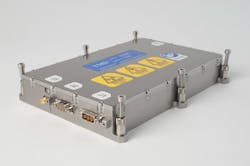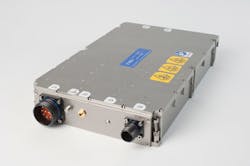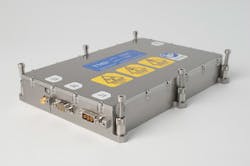Download this article in .PDF format
Amplifiers come in many shapes and sizes, especially as device technologies such as gallium nitride (GaN) have achieved high output levels in small packages. But in some cases, older technologies such as traveling-wave-tube amplifiers (TWTAs) are still in use and still useful solutions for many applications. There are clear differences between solid-state amplifiers and TWTAs in terms of output power, packaging, and power supplies, and understanding the differences between the two technologies helps to simplify the process of choosing the optimum amplifier for an application.
The microwave industry once relied heavily on TWTAs for amplification, although solid-state power amplifiers (SSPAs) have made great inroads over the last few decades, starting with silicon bipolar transistors, then extending at higher frequencies with gallium arsenide (GaAs) transistor devices, to a present-day expansion of applications relying on solid-state amplifiers that build upon GaN transistors and integrated circuits (ICs). Fans of solid-state amplifiers like to point out that they are not victims of the single failure point (the tube) as in TWTAs, although TWTAs typically deliver reliable operation and long operating lifetimes, even with the single failure point compared to SSPAs. TWTAs are still used in broadband applications, such as broadcasting, radar, and satellite communications (satcom) systems. Two types of tube devices are used in these amplifiers: broadband amplifiers are typically based on helix TWT devices while narrowband amplifiers may use coupled-cavity TWTs in amplifiers at higher power levels.
While debate may still rage over which technology—vacuum tube versus solid state—is better suited to RF/microwave applications, the technologies have generally settled into fitting different requirements and needs, with the generalizations often made that TWTAs can provide higher output-power levels for a given microwave frequency range than solid-state amplifiers, although their housing may be larger and heavier and have higher power-supply requirements. But at least one firm, TMD Technologies Ltd., has been pushing to overcome the size differential typical between solid-state amplifiers and TWTAs, although the tube amplifiers usually are capable of higher output-power levels, especially at higher frequencies. In fact, as solid-state devices tend to lose output power at higher frequencies, such as upper microwave and millimeter-wave frequencies, tube amplifiers are still valid solutions for applications at these higher frequencies.
Side by Side
Perhaps the easiest way to evaluate the difference between an SSPA and a TWTA is to compare the performance levels and characteristics of two commercial products, such as the model PTS6900 SSPA and the PTXM1000 range of mini-TWTAs, called microwave power modules (MPMs), both from TMD Technologies. Both were developed to serve the defense and aerospace markets.
The PTS6900 SSPA (Fig. 1) is an SSPA supplied in a compact housing measuring 325 × 200 × 50 mm and weighing 4.5 kg. For a solid-state amplifier, this is very “tube-like” in its performance, with 150 W continuous-wave (CW) output power from 2 to 6 GHz. It delivers 55 dB typical gain, which is adjustable over a range of 50 to 60 dB. The gain remains stable within a 2-dB window across the frequency range. The solid-state amplifier is intended mainly for wideband electronic-countermeasures (ECM) and electronic-warfare (EW) applications, but can be used in any application that requires a high power level over such a broad bandwidth. It is fully compliant with the conducted and radiated electromagnetic-compatibility (EMC) requirements of MIL-STD-461F.
The rugged amplifier builds upon 0.25-um GaN MMIC power amplifier technology and the use of low-loss power combiners to preserve the output levels achieved by multiple GaN devices. The SSPA module can be supplied with a heatsink to control heat buildup, or without one and mounted onto a metal surface or other means of dissipating the heat generated by the active devices.
The SSPA amplifier is designed to operate with a +28-VDC power supply. It minimizes harmonic levels to -20 dBc or better and exhibits a noise figure of 10 dB. It is equipped with an SMA female input RF connector, a TNC female RF output connector, and an SMA female sample RF output connector, with circular military type monitor and control connectors and primary input power connector. The amplifier is designed for operating temperatures from -40° C to +70° C and altitudes of 0 to 70,000 ft.
The 2-to-6-GHz SSPA is completely ITAR-free. It provides an instant startup as well as a fast mute time (only 1 μ) along with extremely high reliability of more than 30,000 hours mean time before failure (MTBF). The SSPA includes DC/DC converters and EMI filters to be fully compliant to MIL-STD-704F & MIL-STD-461F.
So how does it compare with or differ from a tube amplifier? The broadband MPMs offered by TMD Technologies compare in size and weight to their solid-state amplifiers. The PTXM series of MPMs (Fig. 2), including the model PTXM1001 with 100-W CW output power from 6 to 18 GHz and as much as 140 W saturated output power from 6 to 13 GHz, take advantage of miniature TWTs and extremely efficient packaging to achieve small size even with broad frequency ranges and high output-power levels. Measuring only 205 × 120 × 36 mm and weighing no more than 1.95 kg, the PTXM1001 TWTA operates at a 100% duty cycle and delivers 100 W typical output power from 6 to 18 GHz. The nominal small-signal gain is 58 dB.
While it lacks the gain adjustment range of the 2-to-6-GHz SSPA, it is a somewhat higher-density design that includes an optimized switch-mode power supply for the tube. By integrating the power supply with the tube, rather than combining them as separate units, it is possible to eliminate interconnections between the two and reduce the overall size of the MPM housing. Because a number of different TWTs can fit into the amplifier package, the basic design can be configured for a number of different frequency ranges and output-power levels. The model PTXM1001 MPM is well suited for EW and communications applications and is one of the models that can operate in both pulsed and CW modes of operation. In conjunction with the small size of their enclosures, this series of MPMs features excellent thermal management, to ensure minimal heat buildup from the TWTs inside the housing and consequently high reliability. They also achieve high electrical efficiency and maintain consistent performance over the similar operating temperature range as the SSPA, at -40° C to +70° C.
These MPMs include a design in which the high-voltage section is fully encapsulated. This ensures that the tube amplifier can operate at high altitudes and high humidity and will survive high levels of vibration and shock for operation in the harshest military environments. The small size and weight of these high-power tube amplifiers has made them attractive for use in some emerging military applications, such as in unmanned aerial vehicles (UAVs).
According to TMD Product and Technology Development Manager, Dr. David Cook, “The exceptionally low weight and small size of these units, but with no loss of power or reliability is a big advantage for airborne applications such as UAVs—or indeed any situation where space and weight are critical. The modular design makes it easier to manufacture and test each module separately, resulting in lower cost and greater flexibility”
In short, the difference between SSPAs and TWTAs (or MPMs) is no longer that obvious, although the tube amplifiers are still capable of higher output-power densities than solid-state amplifiers. But as designers learn to make tubes and the surrounding circuitry more compact, tube amplifiers are now rivaling the size of solid-state amplifiers for a given frequency and power level.
About the Author
Jack Browne
Technical Contributor
Jack Browne, Technical Contributor, has worked in technical publishing for over 30 years. He managed the content and production of three technical journals while at the American Institute of Physics, including Medical Physics and the Journal of Vacuum Science & Technology. He has been a Publisher and Editor for Penton Media, started the firm’s Wireless Symposium & Exhibition trade show in 1993, and currently serves as Technical Contributor for that company's Microwaves & RF magazine. Browne, who holds a BS in Mathematics from City College of New York and BA degrees in English and Philosophy from Fordham University, is a member of the IEEE.


